A peek into history
Public gets rare look inside original Port Columbus airport terminal
By Allison Ward The Columbus Dispatch
Kitty McLaren marveled at the scuffed-up brick and worn stone columns.
Although no longer the showstopper that it undoubtedly was during its heyday of the 1930s and ‘40s, the dilapidated, yet stable, original Port Columbus airport terminal still proved to be a place of wonder.
“I didn’t realize how beautiful this building was,” said Clintonville resident McLaren from inside the historic terminal on the 5th Avenue side of John Glenn Columbus International Airport.
No doubt adding to the awe is the structure’s rich history, involving names such as Charles Lindbergh and Amelia Earhart — and the fact that the public isn’t normally allowed inside.
However, those working to preserve the building — and the nearby Hangar One — and possibly turn it into a state air and space museum invited anyone who was curious to tour the terminal Saturday afternoon in commemoration of its 90th anniversary.
They also hosted a celebration dinner in the hangar.
“The 90th anniversary might sound like an oddball year, but there’s been enough positive things going on ... that we wanted to keep public awareness going,” said Tom Kromer, one of the organizers.
Hundreds of fellow history buffs, along with eager photographers and those simply interested in all things Columbus, showed up to get a peek inside.
Port Columbus opened in 1929 as the easternmost air link in the innovative New York to Los Angeles route on Transcontinental Air Transport. Passengers arrived in Columbus via train from New York, then flew in a Ford TriMotor to Waynoka, Oklahoma. Finally, they boarded another train to complete their trip to Los Angeles.
It took 48 hours to get coast to coast, half the time a trip by train alone took, Kromer said.
“This is the birthplace of commercial aviation,” Kromer said. “If you’ve ever flown in an airplane, you can do this because of what happened here.”
That thought was not lost on Doug Terpstra as he stood in the lower part of the control tower, perhaps where Tuskegee Airman Alex Boudreaux, who is thought to have been first black air traffic controller, once stood. Camera in hand, Terpstra, a North Side resident, jumped at the chance to tour a historic building.
“On a recreation basis, opportunities like this don’t come up very often,” said Terpstra,
45. “These aspects of early aviation are still in Columbus, and the fact that any of it survives is amazing.”
Abbey Bauer — dressed as Earhart — said she’s thankful that groups such as the Columbus Historical Society and other enthusiasts preserved the original Port Columbus, given that there were discussions just a few years ago about tearing down the now-obsolete buildings.
“I didn’t know that Amelia Earhart and Charles Lindbergh were involved in the Columbus airport,” said the 33-year-old, who has performed as the famed female pilot at the historic Green Lawn Abbey mausoleum. “Ohio is known for astronauts and the Wright brothers, but this is another level of aviation pedigree.”
She and her husband, Tom, were fascinated that Columbus was such a hub for aviation activity, and they hoped the public viewing would create a greater appreciation for that history.
That’s what Kromer and others interested in finding a way to restore these structures are banking on, despite past failed attempts.
“We’re hopeful they can find a way to repurpose it,” said Don Casto III, a member of the Columbus Regional Airport Authority board, referring to the historical groups. The airport owns the buildings but is working with these organizations and grassroots efforts to identify a solution.
Kromer said he would like the new space to become the Ohio Air & Space Hall of Fame and Museum if they can raise the capital.
“This place just oozes history,” he said. “There are 8 million people who fly out of this airport every year, and no one knows about it.” award@dispatch.com @AllisonAWard

